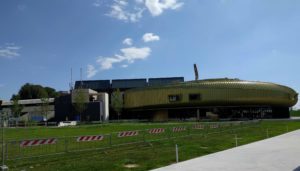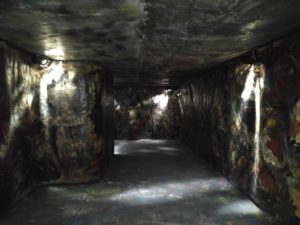 8 April 2017 – 28 January 2018
8 April 2017 – 28 January 2018
Centro per l’Arte Contemporanea Luigi Pecci
Viale della Repubblica, 277, Prato, Italy
http://centropecci.it
With the exhibition “From the Cavern to the Moon” the Centro per l’Arte Contemporanea Luigi Pecci and the curator Stefano Pezzato invite the visitor to make a journey through the collection purchased since 1988 by different managements and curators. All works have in common, that they are dealing with their environment or became part of it. That might be through extensive installations which create new spaces, and/or references to the social, cultural, economic or technical conditions.
The oeuvres by 60 Italian and international artists are getting in dialog to each other through their division in eight sections. It might be a formal conversation or combinations of artistic genres, stylistic groups or historical chronologies. Before, these works were presented in various exhibitions of the centre, newly acquired or had never been on view before. Overall, it is art of the last 50 years, partly shown in the old edifice of the collection and the new building. From the outside, this new edifice is looking a little bit like a spaceship, with which we can travel through space and time.
 As point of departure serves Pinot Gallizio’s cavern of antimatter (La Caverna dell’antimateria) from 1957/58. By the title, it expresses the same spectrum like the exhibition’s title: the “cavern” refers to the times when human beings used to live in caves, but the term “antimatter” implies a scientific approach. In reality, the cavern of antimatter is an installation of 145 meters of industrial paintings, first on view at the gallery Drouin in Paris in 1959. Invented by Pinot Gallizio, “industrial painting” follows the style of industrial mass production: they are created by the use of paint rollers, spray guns, machines applying resins and they are sold by the meter. In consequence, the cavern of antimatter is not only a created space, but also a reference to the contemporary conditions of production and the commercialisation of goods. Thereby it contains societal and economic aspects.
As point of departure serves Pinot Gallizio’s cavern of antimatter (La Caverna dell’antimateria) from 1957/58. By the title, it expresses the same spectrum like the exhibition’s title: the “cavern” refers to the times when human beings used to live in caves, but the term “antimatter” implies a scientific approach. In reality, the cavern of antimatter is an installation of 145 meters of industrial paintings, first on view at the gallery Drouin in Paris in 1959. Invented by Pinot Gallizio, “industrial painting” follows the style of industrial mass production: they are created by the use of paint rollers, spray guns, machines applying resins and they are sold by the meter. In consequence, the cavern of antimatter is not only a created space, but also a reference to the contemporary conditions of production and the commercialisation of goods. Thereby it contains societal and economic aspects.
Fabio Mauri created another to the title referring artwork in 1968, as he reached for the stars. Even six months before the landing of the Apollo 11 he presented “Luna” at the Galleria La Tartaruga in Rome. Once again installed in the Centro Pecci, the visitor can enter the moonscape through rectangle openings with rounded corners, like in a spaceship. Inside white polystyrene beads on the floor awaits the public. The soft ground gives the impression to walk in weightlessness and allows the visitor to move, sit, lie or whatever in the sea of polystyrene.
Beside these two historical installations, there are many others, which permit new space experience. Paolo Scheggi’s “Intercamera plastica” (Plastic Antechamber) from 1967 dives the world into the yellow.
Superstudio carries off the view into a space of thousands of reflexions due to the installation “Supersuperficie” from 1971/72 (reconstruction 2011).
Carlos Garaicoa shows how the earth wishes to resemble the sky, (De como la tierra se quiere parecer al cielo II) from 2016. Created site specific for the reopening exhibition of the Centro Pecci “La fine del mondo” (The End of the World), one could discover how our nightly towns are similar to the starry sky seen from above.
However, there are also less expansive artworks, which are dealing with space and environment. An absolutely two-dimensional example is the photo “Andy Warhol” by Maria Mulas from 1987. Still, the portrayed targets out of the flat image and takes aim at the onlooker.
Michael Fliri’s video “0O°°°oo0Oo°O0” from 2010 gives us the opportunity to follow the efforts of someone moving upside down under water.
The collective “Factory of found clothes” illustrates in the video “Scarlet Sails” from 2005 the clash of generations in the communist Russia and the request to hang on to dreams. Five senior women entering a sewing factory, where five younger women are working. After a musical performance, the seniors wrest the dreams symbolising cloth from the younger and take it outside to the sea. Now, the – until then – only black and white video gains colour since the cloth turns red. The dream of the scarlet sail is released and not any longer trapped in the grey factory. It is a homage to the Russian author Alexander Grin, who wrote the novel “Scarlet Sails” in 1923.
Whereas, Vahram Aghasyan’s photos of “Ghost Cities” from 2005 are showing residential buildings of Mush close to Gyumri, Armenia. Constructed to host people after a terrible earthquake, they were never finished, due to the collapse of the Soviet Union: a busted dream of a better future.
Umberto Borella, the responsible for the exhibition design, placed them luckily at the start of Henrique Oliveira’s “Transcorredor” from 2016. Positioned on the white wall the photos refer to the following passageway, which is looking unfinished like the edifices in the photos. The Trans-corridor changes hereafter several times its construction material, gets narrow and squirms like an underground pathway. Once again, the visitor is in a cavern.
Coming out from this sensual spatial experience one is awaited by Marcos Chaves untitled photo series from 1996/2008 representing unconventional filled holes in the street. These images, reminding construction sites and fit so very well into the discourse of the previous artworks.
Hereafter the visitor can discover new spaces and environments, and make a journey through the Collection of the Centro Pecci with oeuvres by
Vito Acconci, Vahram Aghasyan, Archizoom Associati, Marco Bagnoli, Pier Paolo Calzolari, Paolo Canevari, Loris Cecchini, Marcos Chaves, Giuseppe Chiari, Fabrizio Corneli, Enzo Cucchi, Gino De Dominicis, Ulan Djaparov, VALIE EXPORT, Jan Fabre, Factory of Found Clothes, Sylvie Fleury, Michael Fliri, Lucio Fontana, Pinot Gallizio, Rainer Ganahl, Marco Gastini, Nan Goldin, Franco Grignani, Pietro Grossi, Shirazeh Houshiary, Ilya Kabakov, Anish Kapoor, Dani Karavan, Joseph Kosuth, Jannis Kounellis, Ketty La Rocca, Sol LeWitt, Francesco Lo Savio, Amedeo Martegani, Fabio Mauri, Mario Merz, Robert Morris, Maria Mulas, Ugo Mulas, Bruno Munari, Marco Neri, Lamberto Pignotti, Michelangelo Pistoletto, Chris Sacker, Remo Salvadori, Paolo Scheggi, Julian Schnabel, Keith Sonnier, Esther Stocker, Superstudio, David Tremlett, UFO, JCJ Vanderheyden, Luigi Veronesi, Massimo Vitali, Andy Warhol, Erwin Wurm, Gilberto Zorio.
































